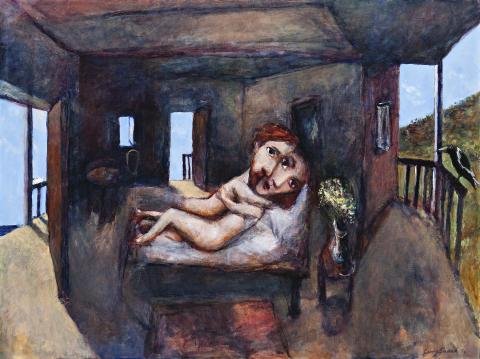MORNING, 1994 (FROM ‘D.H. LAWRENCE’ SERIES)
GARRY SHEAD
oil on canvas
90.5 x 121.0 cm
signed and dated lower right: Garry Shead 94
signed, dated and inscribed with title verso: OIL. ‘MORNING’ ‘94 GARRY SHEAD
Dover Street Gallery, London (label attached verso)
Michael Nagy Fine Art, Sydney
Private collection, Sydney
Kangaroo: The D.H. Lawrence Series, Dover Street Gallery, London, 3 – 30 November 1994 (as ‘Awakening’)
The Awakening, 1993, oil on canvas, 91.5 x 122.0 cm, illus. in Grishin, S., Garry Shead and the Erotic Muse, Craftsman House, Sydney, 2001, pp. 92 – 93
Under the steady gaze of a voyeuristic magpie, the lovers lay intertwined on a simple bed, savouring the early morning sunlight and sea breeze sweeping through the open windows and doorways of their wooden shack. Morning, 1994 is a major work from the artist’s iconic series inspired by D.H. Lawrence’s semi-autobiographical novel, Kangaroo, written in 1922 while the author was residing at the coastal town of Thirroul in New South Wales. Comprising over twenty oil paintings, Shead’s D.H. Lawrence series is resplendent with poetic metaphors on human existence. Each scene is a personal thematic exploration of an excerpt from Lawrence’s novel, often featuring its protagonists, Richard Somers and his wife Harriet. Morning is a typical example of this series and though it does not feature the leitmotif of a spying kangaroo (representing the novel’s antagonist, the political activist Cooley) the intimate scene is infused with a sense of anticipation and possibility.
Shead first started reading Lawrence’s works during a 1968 trip to the Sepik region of Papua New Guinea, and continued to revisit them over the next three decades. In the 1970s, Shead painted a small series of portraits of the author and views of the areas that Lawrence had visited in 1922, one of which was made in collaboration with Brett Whiteley in 1973. However, it was only upon moving to the coastal town of Bundeena with his wife in 1987 that Shead embarked on a large scale narrative series inspired by Kangaroo. Signalling the creative apotheosis of over four decades of personal and philosophical fascination with the author and his works, the D. H. Lawrence series would become Shead’s most publically acclaimed and sought-after paintings.
The lovers, as an embodiment of a recurrent theme throughout Shead’s oeuvre, erotic impulse, symbolise creative union and oneness with the physical landscape. The D.H. Lawrence series presented Shead with the possibility of combining several of his preferred themes: the coastal landscapes of New South Wales, particularly as an expression of the spirit of the land, the nude within landscape, Australian national identity and a personal affinity with Lawrence nourished by a series of anecdotal parallels. Shead and his wife Judith in residing in Bundeena felt a particular connection to the experiences of D.H. Lawrence and his wife Frieda in their house, Wyewurk, in the coastal town of Thirroul some fifty years prior. These affinities even extended to the fictional struggles of the protagonists of Kangaroo, in their bungalow, Coo-ee, in Mullumbimby.
As Sasha Grishin notes in his monograph Garry Shead and the Erotic Muse, while Shead did not view himself as a re-incarnation of the writer, this series of paintings establishes a complex pattern of synchronicity and interchangeable identities and temporalities between the three couples. 1 By blurring the lines between physical markers of reality and slightly surreal scenes, Shead constructs his own vein of magical realism, complete with an antipodean allegorical bestiary.
1. Grishin, S., Garry Shead and the Erotic Muse, Craftsman House, Sydney, 2001, p. 94
LUCIE REEVES-SMITH
